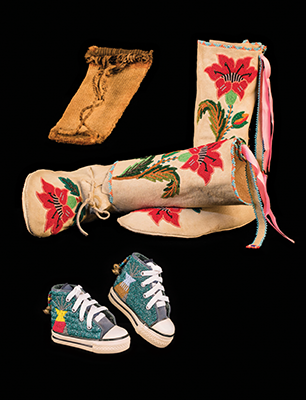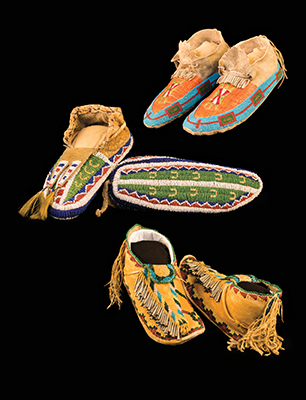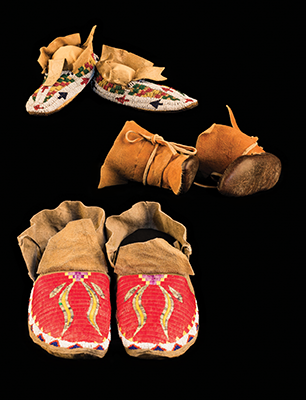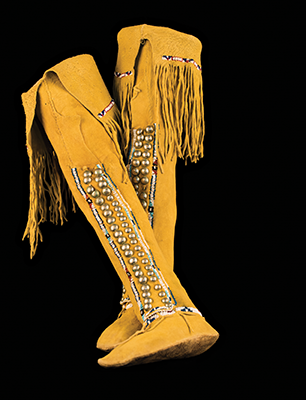Lasting Impressions
Follow the shoes’ clues in Stepping Out: 10,000 Years of Walking the West.
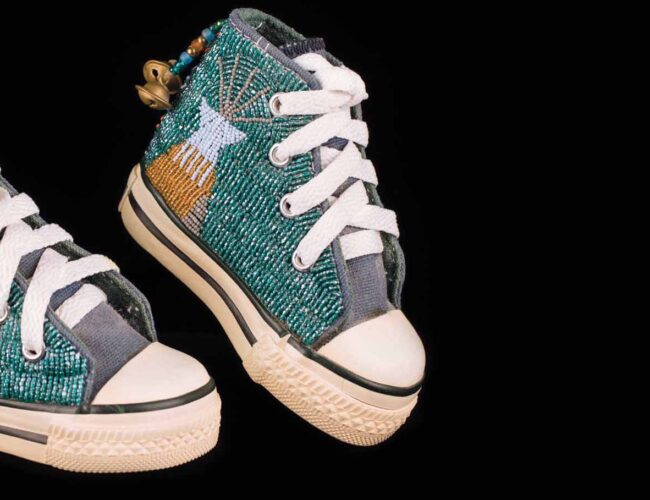 Young child’s Converse All-Star shoes beaded by Teri Greeves (Kiowa/Comanche) in 1999. MIAC 59864/12.
Young child’s Converse All-Star shoes beaded by Teri Greeves (Kiowa/Comanche) in 1999. MIAC 59864/12.
BY MAXINE MCBRINN
Years ago, I fell in love with ancient sandals. These simple sandals were worn 2,000 to 3,000 years ago by Ancestral Pueblo people and were preserved in the dry enclosures of rock shelters, where they had been left behind when people moved on. Some showed wear and age, others looked and felt almost as fresh as the day they were set down by the people who made them.
When I hold an ancient sandal in my hand, it tells me about the culture of the wearer and the maker, but it also allows a direct connection, one that is visceral in its strength, to the individual who wore it. I see where their heel wore through the sandal and where each toe left an indentation, where patches were applied to make the sandal last a bit longer. Archaeologists who study pottery rave about the rare fingerprint left behind on the clay—that touch that transcends the centuries. Every sandal, however, speaks about the person who wore it.
People have been protecting their feet from the rocks and thorns of the world for millennia. Sometimes those shoes have been designed primarily for function and made from suitable or easily available materials. At other times, people have used their footwear to make a statement about their place in the world—think of the Dr. Martens boots beloved by real and would-be punks in the 1980s, and Carrie Bradshaw’s Manolo Blahniks in Sex and the City, not to mention countless young men who just had to have the athletic shoes of their dreams.
I carried my love for ancient sandals with me when I became a curator at the Museum of Indian Arts and Culture (MIAC). During my tour of the collections when I interviewed, I saw cabinets with many beaded Plains moccasins and, then and there, thought how wonderful it would be to feature them and ancient sandals in an exhibition. MIAC specializes in the American Southwest, so most of these moccasins had never been exhibited. Later, I realized just how exciting contemporary art shoes are and happily added them to my scope. It’s a great honor and even bigger pleasure that our exhibition, Stepping Out: 10,000 Years of Walking the West, will open to the public on August 27, 2017 and will remain on display for more than a year.
Regardless of their origin, shoes speak eloquently of the individual who wore them. The size of the shoe will often indicate whether they were worn by a child or an adult. It’s also often possible to guess whether the adult was a man or a woman. Wear patterns show the shape of the foot and hint at the gait of the wearer. Did the wearer have bunions or flat feet? Did they shuffle their feet as they walked? The shoes will tell.
Footwear also tells the viewer about culture and even about sub-cultures. Almost always, people make shoes that look like the shoes they see around them. They use techniques that are common for their time and place. For example, southwestern Ancestors made sandals, usually from yucca leaves and fiber, from 10,000 years ago until about AD 1300, when they switched to making moccasins. We don’t know why they made the change, but it came at the same time that people were leaving the Four Corners area and were moving to join their friends or relatives in the southern parts of what are now the states of New Mexico and Arizona, and along the Rio Grande. During this profound social upheaval, footwear changed too. At the exhibition, you can watch a video of Mary Weahkee (Comanche/Santa Clara) making a Mogollon-style pair of yucca sandals, and giving visitors the guidance needed to make their own pair. (Laurie Webster will write in more detail about ancient, Southwest sandals in a later issue of El Palacio.)
Today and in recent history, all the Pueblos, the Navajo, and the Apaches wear moccasins at ceremonies and as a part of their everyday lives. These moccasins have hard soles made with rawhide and softer brown, white, or other colored uppers. Men’s moccasins tend to be ankle height or shorter, although there are exceptions. For women, though, moccasins extend to the knee. Among the Navajo and for many of the Pueblos, long pieces of leather wrap around the leg of the woman to extend the covering. At other Pueblos, such as Taos, very long leather uppers are folded so as to not extend too high. These moccasins, and other styles worn by men, can be seen today at Pueblo Feast Days and at other public ceremonies.
Moccasins made correctly, using the right patterns and with the right colors, tell knowledgeable viewers who the people wearing them are. Because of footwear’s ability to express cultural belonging, in 2012 Jessica “Jaylyn” Atsye of Laguna Pueblo established Rock Your Mocs Day, officially November 15th but now a week-long celebration, as a way of reclaiming and proclaiming Native identity. In the process, she created a movement that has grown across the country. (You can find out more at facebook.com/rockyourmocs.)
Outside the Southwest, others in western North America also made sandals and moccasins, with sandals being common in the Great Basin (Utah, Nevada, and the eastern parts of Oregon and California) and other arid areas and moccasins worn almost everywhere else. Both in the past and today, strong regional differences in the construction and style of shoes allow viewers to identify the origin of the wearers or the makers.
Before glass beads came into the picture, makers traditionally decorated footwear with paints or flattened and colored porcupine quills, or left the shoes undecorated. After European colonists and explorers introduced beads, the distinctiveness of many tribes’ moccasins grew. Glass beads were and are made in the Old World, initially in Europe but more recently also in parts of Asia. Native artists eagerly accepted and used beads as soon as they were available through trade or as payment or, less commonly, as gifts. By the 1800s, beads were available across much of North America.
Beads provided a powerful transformation for moccasins, as makers adapted long-used designs to this new medium. The beads’ vibrant colors and iridescence allowed new kinds of styles to be created. In the West, makers decorated many beaded moccasins with abstract, usually geometric, designs drawn from the complex language of symbols that had been in use for millennia, sometimes as decoration on other media, like parfleches or on other kinds of clothing. These designs offered representations of the landscape they lived in and the people’s role in it; epic stories that explained the origin and shape of the world, and how to live properly in that world. Specific designs were often “owned” by a family or a society and could only be completely understood by members of that group. Glass beads allowed these important, symbolic statements to become more obvious, while adding beauty to the life of the wearer and who could see him or her.
Beading moccasins also demonstrates the care and thought that goes into making clothing for a family member or close friend. When working, today’s beaders, like many other Native artists, concentrate on positive thoughts, from why they are making the piece to how the owner’s life will be enriched by it. The beauty of the final product shows this love and respect.
To build a pair of moccasins, animal skins must be defleshed and tanned. Brain-tanned deer, buffalo, elk, or moose hides are most commonly used, although today many buy their leather prepared or use commercial cow hide. Each moccasin is made for the individual, so the wearer stands on the leather, or if they are not local, outlines each foot on a piece of paper, then also measures the distance from the sole to the top of the foot, so that the moccasin will fit perfectly. The uppers are created, including all the beading, separately from the sole, which is attached later. For some tribes, the upper is sewn on to the sole inside out, so that the moccasin must be turned right side out as the last step, a perilous process if there a many beads on the uppers.
While beads became the most common design medium, some moccasins were still decorated with quill work, as were other personal items. The application of commercially available dyes gave quilled designs more visual impact, which combine beadwork with the quilled design. This pair clearly demonstrates another feature: The design is meant to be read by the wearer rather than the viewer. What seems at first glance to be a loose floral design actually shows the antlers and ears of an animal, perhaps in the form of a headdress—you just have to look at it as if you were wearing the moccasins to see it correctly.
Close confinement with people from other tribes was an aspect of life for many western Native Americans during the Reservation Period (the mid to late 1800s). Prior to this time, there was some level of intermarriage between tribes and occasional trade gatherings that allowed people to mix more freely, but the level of exposure to others’ ways of life, and their moccasin and clothing designs, intensified after being forced to live together on reservations. Moccasin makers and other artists began to borrow designs, color choices, and other decorative aspects from each other, creating new kinds of objects that reflect this exchange of ideas and techniques. For example, Arapaho tribal members who were confined with Sioux bands began to apply some Sioux design aspects to shoes that otherwise looked Arapaho, perhaps decorating the top of the collar with a band of fabric, or forgoing an otherwise obligatory lane of beaded design over the instep. The exhibition features a number of moccasins that show these shared designs and techniques. One particularly fine example is a pair of moccasins where the vamp (the area on the top of the foot) is decorated with very distinctive Hidatsa quillwork, but the beaded perimeter along the edge of the foot is beaded in the Cree style. The moccasins may have been made for a family member in a mixed marriage, or by two artists from the two tribes working together.
Many moccasin designs, particularly on the Great Plains, alluded to the lifeways of the people with design fields that refer to important animals, like hoof prints of deer or bison, or the U-shape of a horse’s footprint. They could also instruct the wearer in other ways. Some designs on moccasins depict how people properly move and use space in a tipi, recall sacred landscape features, or refer to features in the sky. All of them remind the person wearing the moccasins who they are and how they fit into the world, a message delivered every time the wearers look down at their feet.
The Reservation Period’s lack of customary employment gave moccasin makers more time to spend decorating moccasins, so that some of the most ornately decorated pairs date from this time. One style of shoe still astonishes us today—fully beaded moccasins, so completely beaded that the designs cover not just the tops of the moccasins but also the soles of the shoes. These moccasins, most commonly made by Sioux artists but also by nearby tribes, are sometimes called “death moccasins,” a name that erroneously reflects a belief by outsiders that these moccasins were not made to be walked on and therefore were for funerary use. In fact, many of these moccasins were created for use in ceremonies during which an individual, either a child or young woman, was especially blessed and, during the ritual, not allowed to touch the earth with their feet. Some brides were also carried to their husbands’ family tipis wearing beaded-sole moccasins. Later, after federal authorities discouraged or outlawed traditional Sioux ceremonies, artists made beaded-sole moccasins for special occasions: the return home of a soldier; to honor high school or college graduates; to welcome special visitors to the tribe; and for many other events and purposes. They are a form of celebration that also shows great respect for the lucky recipient.
In other cases, the beaded soles show the wealth of the wearers, who didn’t need to walk because they had horses and could ride wherever they needed to go. There are historic photos that show men wearing beaded sole moccasins as they sit around a fire. Many of the moccasins show wear on the soles, making it clear that they were walked on. Others show wear that is localized to where the stirrups would have rubbed, supporting the idea that the wearers were able to ride to their destinations most of the time. I think of these moccasins as being something like the shoes worn by the girl in a Paul Simon song who was so rich she had “diamonds on the soles of her shoes.” Come to think of it, some beads glitter as beautifully as diamonds.
Men on the Southern Plains were also able to show their status and wealth with their shoes. Many men’s moccasins from the Kiowa, Comanche, Southern Cheyenne, and some Apache tribes have a fringe that decorates the outside edge of the vamp and another, very long fringe attached to the heel of the shoe. Moccasins with heel fringes are often called “dusters” in the belief that they were meant to erase the tracks made by the wearer. This sounds like a cunning plan, but I have been told by Vanessa Jennings, a renowned Kiowa bead artist, that the fringes were actually an announcement to the world that the wearer didn’t need to walk, they rode instead. Historic photos back this up when they show how beautifully the heel fringes drape when worn to ride. Walking in these moccasins may have led to moments of difficulty. A Pueblo elder recently told a story about a young boy, decades ago, who delighted in repeatedly stepping on the heel fringes of the esteemed leader in front of him during the ceremonial procession to bless the fields. This particular boy can’t have been the only one inspired by such an opportunity!
For both men and women, most moccasins were worn with leggings, a sort of sleeve that covered all or the bottom part of the leg. These were often also beautifully decorated in ways that augmented the moccasins’ designs. Two of the full outfits shown in the exhibition include elaborately decorated leggings. In some parts of the Southwest and the Plains, leggings were eventually attached to the moccasins, creating something that looks more, to our modern eyes, like boots. One fine example of this sort of “tall moccasin” is a pair of Comanche women’s moccasins. These boots were rubbed with ochre to make them a vivid yellow, and decorated with a double row of metal buttons and fine lines of beading. The fringe on the top adds a dramatic flair. Tall moccasins protected the legs of the wearer from chafing and scratches from grasses and bushes while riding horseback. To my eyes, they are footwear worn by strong, confident women.
Taller moccasins were also worn by women on the northwest Plains and into the Great Basin and Plateau areas. Some groups continued to decorate their moccasins with geometric designs, while others borrowed styles from Europeans and made them their own. Among the more eye-catching are the detailed floral designs made by the Shoshone, Ute, and other groups. The most common floral design used on Shoshone moccasins was the rose, a pattern that is still so common that it is called “the Shoshone rose.” Several examples are included in the exhibition. These designs could not be rendered using the most common beading technique, called the lane or hump stitch, in which short lines of beads are sewn side-by-side to create a pattern that covers the surface. Instead, these flat designs require a spot or two-needle stitch, wherein each bead or couple of beads are tacked down using thread or sinew. This also more securely attaches the beads to the surface of the shoe. If you look inside a garment or shoe decorated in this manner, you would see thread from the back side of each stitch, just like in embroidery. In contrast, in lane stitching the needle generally only skims the surface of the leather and rarely penetrates its full depth, leaving little evidence on the reverse side.
Some of the Native American bead and leather artists still making moccasins today continue to work using traditional materials and designs to ensure that they and their families and friends have appropriate footwear for everyday life and for ceremonies. Some artists specialize in creating highly decorated moccasins for Powwows, where exuberant elaboration is welcome. Many of these artists can produce moccasins in many styles, easily incorporating a wide range of tribal patterns at the request of their customers.
Other artists are applying traditional designs or techniques to new creations. Some make shoes that look traditional but with a modern twist; others produce startlingly new forms. Stepping Out finishes with a sample of what these artists are doing and a video of Teri Greeves (Kiowa/Comanche), a local artist, speaking about the shoes she makes, and her beading in general. Kate Nelson will discuss contemporary Native footwear in a future issue of El Palacio.
No matter the period, medium, or technique, footwear is intensely personal even while it simultaneously makes a statement to the world about belonging, aspiration, and identity. Painted Toms, beaded Chucks, traditional moccasins, and ancient sandals all offer glimpses into individual lives, experiences, and values. Like the related act of walking, these shoes invite contemplation that transcends the everyday.
Maxine McBrinn is the curator of archaeology at the Museum of Indian Arts and Culture. She curated Stepping Out: 10,000 Years of Walking the West, and has written or contributed to many books and articles about the archaeology of the Southwest.

